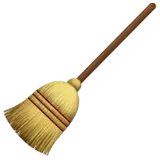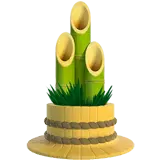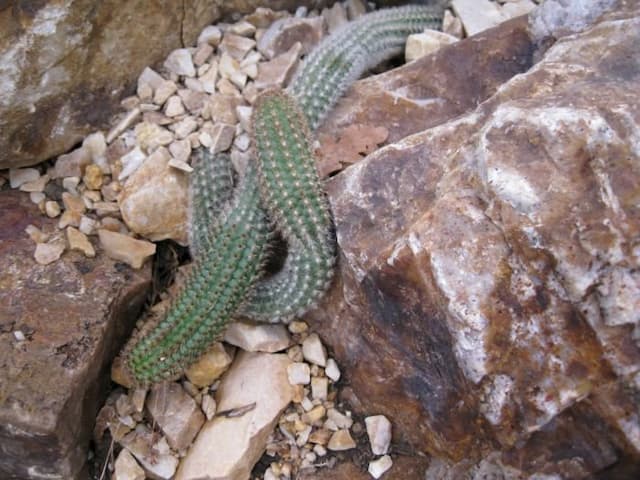Lemon Ball Cactus Mammillaria surculosa

ABOUT
Mammillaria surculosa, commonly referred to as the Pincushion cactus due to its small, rounded shape resembling a cushion filled with pins, is a globular cactus that presents with tightly packed clusters. The body of this plant is covered in small, white, hair-like spines which give it a soft, fuzzy appearance, interspersed with longer, sturdier spines that can vary in color from reddish-brown to yellow. The surface is divided into numerous tubercles—small, rounded, bump-like protrusions—from which the spines emerge. These tubercles are spirally arranged and add to the plant's ornamental appeal. The Pincushion cactus blooms with flowers that can range in color, often displaying vibrant hues that contrast beautifully against the green of the cactus body. The flowers typically form a crown-like ring near the top of the cactus, further enhancing its decorative look. After flowering, small, club-shaped fruits may develop, adding to the textural interest of this charming and compact cactus.
About this plant
 Names
NamesFamily
Cactaceae
Synonyms
Pineapple Cactus
Common names
Mammillaria surculosa.
 Toxicity
ToxicityTo humans
The Mammillaria surculosa, commonly known as Pinecone Cactus, is not considered a toxic plant to humans. There are no widely reported symptoms associated with poisoning from this plant, as it is generally not known to be poisonous upon ingestion. However, physical irritation might occur if the skin comes into contact with the cactus spines.
To pets
Similar to its effect on humans, the Pinecone Cactus is not toxic to pets. Ingestion of this plant should not cause poisoning in animals such as dogs or cats. Nonetheless, caution should be taken to prevent pets from ingesting or interacting with this cactus, as the spines can cause physical harm or irritation.
 Characteristics
CharacteristicsLife cycle
Perennials
Foliage type
Evergreen
Color of leaves
Green
Flower color
Pink
Height
6 inches (15 cm)
Spread
4 inches (10 cm)
Plant type
Cactus
Hardiness zones
9
Native area
Mexico
Benefits
 General Benefits
General Benefits- Low Maintenance: Mammillaria surculosa, commonly known as the Pineapple Cactus, requires minimal care due to its adaptation to arid environments.
- Drought Tolerant: It can survive long periods without water, making it ideal for water conservation in gardening.
- Aesthetic Appeal: With its distinctive pineapple-like appearance, it adds unique visual interest to succulent collections and rock gardens.
- Easy Propagation: It can be easily propagated from offsets, allowing gardeners to expand their collection or share with others.
- Habitat for Wildlife: The flowers of the Pineapple Cactus can attract pollinators like bees, contributing to the biodiversity of the garden environment.
- Educational Interest: Growing Mammillaria surculosa can serve as an educational tool for learning about plant care and desert ecosystems.
- Compact Size: Due to its small size, it is suitable for cultivation in limited spaces such as apartments and small gardens.
 Medical Properties
Medical PropertiesThis plant is not used for medical purposes.
 Air-purifying Qualities
Air-purifying QualitiesThis plant is not specifically known for air purifying qualities.
 Other Uses
Other Uses- Mammillaria surculosa is often used as an ornamental plant for its attractive globular shape and dense spination, making it a popular choice for rock gardens and desert-themed landscapes.
- As a drought-tolerant species, it serves as an ideal plant for xeriscaping, helping to reduce the need for irrigation in arid regions.
- The cactus can be grown in containers and used to decorate patios, balconies, or windowsills, providing a touch of greenery in small spaces.
- It is sometimes used in educational settings, such as schools and botanical gardens, to teach about desert flora and cacti adaptation strategies.
- Due to its compact size, Mammillaria surculosa is suitable for miniature gardens and fairy gardens as a low-maintenance plant choice.
- The textural contrast provided by this cactus makes it a valuable component in mixed succulent arrangements and dish gardens.
- Artists and photographers may use this cactus as a subject for their work, drawing inspiration from its unique form and patterns of spines.
- In horticultural therapy, the care and cultivation of this plant can be used as a tool to improve mental wellbeing and provide a sense of accomplishment.
- Enthusiasts of model railroads and dioramas might incorporate Mammillaria surculosa into their miniature landscapes to add realism to desert scenes.
- Educational kits for children sometimes include seeds or small specimens of this cactus to initiate an interest in plant growth and botany.
Interesting Facts
 Feng Shui
Feng ShuiThe Lemon Ball Cactus is not used in Feng Shui practice.
 Zodiac Sign Compitability
Zodiac Sign CompitabilityThe Lemon Ball Cactus is not used in astrology practice.
 Plant Symbolism
Plant Symbolism- Resilience – Mammillaria surculosa is a variety of cactus, known for their ability to thrive in harsh, arid environments, symbolizing the ability to endure and overcome difficult conditions.
- Protection – Like many cacti, Mammillaria surculosa is covered in spines, which serve as a defense mechanism, representing the concept of protection and setting boundaries.
- Beauty in austerity – This plant can bloom beautiful flowers despite its spiny appearance, symbolizing the idea that beauty can be found even in places or situations that seem unwelcoming or tough.
- Adaptation – The plant's ability to store water and adapt to its environment stands for flexibility and the capacity to adjust to changing circumstances.
 Water
WaterTo properly water a Bubble Cactus (Mammillaria surculosa), allow the soil to dry out completely between waterings, typically watering once every 1-2 weeks during the growing season (spring and summer). In the winter, reduce watering to once a month. When watering, soak the soil thoroughly until water runs out of the drainage holes, which may be around 16-32 ounces depending on pot size and soil dryness. Ensure that the cactus is not left in standing water to prevent root rot.
 Light
LightThe Bubble Cactus thrives in bright, indirect sunlight. It enjoys a spot where it can get plenty of light without being subjected to the harsh midday sun, which can cause sunburn. An east or west-facing windowsill is ideal, where the plant can enjoy the morning or late afternoon sun. Avoid deep shade, as too little light can lead to etiolation, where the plant stretches abnormally towards the light.
 Temperature
TemperatureBubble Cacti prefer temperature ranges between 50°F and 80°F and can tolerate a minimum of 40°F during their dormant winter period. To encourage flowering and proper growth, maintain average room temperatures around 70°F. Avoid exposing the plant to temperatures below 40°F, as it can sustain cold damage, and also be wary of extreme heat above 90°F, which can stress the cactus.
 Pruning
PruningPruning of Bubble Cacti is typically not necessary as they maintain a compact form. If any parts of the plant become damaged or diseased, use sterile, sharp scissors to remove the affected areas. Best time for pruning, if needed, would be in the spring before the growing season begins. This will give the plant time to heal and minimize the risk of infection.
 Cleaning
CleaningAs needed
 Soil
SoilThe best soil mix for the Mountain Ball Cactus (Mammillaria surculosa) is a well-draining cactus mix with pumice or perlite. It thrives in a slightly acidic to neutral pH between 6.0 and 7.5.
 Repotting
RepottingThe Mountain Ball Cactus should be repotted every 2-3 years to refresh the soil and accommodate root growth.
 Humidity & Misting
Humidity & MistingThe Mountain Ball Cactus prefers low humidity environments, typical of its native desert habitat.
 Suitable locations
Suitable locationsIndoor
Place in bright light, avoid overwatering, allow soil to dry out.
Outdoor
Full sun to partial shade, well-draining soil, protect from heavy rain.
Hardiness zone
9-11 USDA
 Life cycle
Life cycleThe life of the Mammillaria surculosa, commonly known as the Pincushion Cactus, begins with seed germination, occurring in warm, moist soil conditions where they develop into tiny seedlings. As they grow, they form a round, ridged stem with areoles from which spines emerge, a characteristic feature of their growth stage. The Pincushion Cactus will then flower, typically in the spring or summer, producing small, bell-shaped flowers around the crown of the stem. After pollination, often facilitated by insects, the flowers may develop into fleshy fruits containing seeds. These seeds can then be dispersed, fall into the soil, and potentially grow into new plants if the conditions are favorable. Throughout its life, the Mammillaria surculosa requires periods of growth and dormancy, usually growing in the warmer seasons and resting in cooler months.
 Propogation
PropogationPropogation time
Spring-Early Summer
Propogation: The most popular method for propagating Mammillaria surculosa, commonly known as Mammillaria cactus, is through offsets. Mammillaria surculosa typically produces small offsets that can be easily separated from the parent plant during the active growing season, typically spring to early summer. To propagate, gently twist the offset away from the mother plant, taking care to preserve the roots. Allow the offset to dry and callous over for a few days to prevent rotting when replanted. Once calloused, plant the offset in a well-draining cactus mix, water sparingly, and provide bright, indirect sunlight. With proper care, these offsets will root and grow into new plants, thereby expanding your collection of these attractive cacti.









